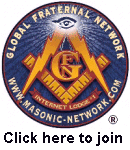
The GFN Treasure Chest Archives
www.masonic-network.com
"Where Master Masons Communicate"

 |
The GFN Treasure Chest Archiveswww.masonic-network.com |
 |
The Masonic Candidate is introduced to this three-storey temple by participating in the Ceremonies of the Three Degrees by which he advances in titular rank from his start as an Entered Apprentice, through the intermediate Degree of Fellowcraft, to the final Degree of Master Mason. This process usually takes place over a period of a few months. If he wishes to practice the Craft as a Mystery, as a means of psychological development, the new Master Mason will thereafter spend many years considering the implications of the Craft's symbolism and observing its principles operating in his life. If he perseveres, he will recapitulate in the events of his day-to-day experience the ritual progress he made therough the symbolic degrees; and by this means he will, in time, achieve the sort of psychological maturity which his title of Master Mason implies. It is a long and arduous undertaking; indeed, it is the labour of a lifetime.
When the Candidate is admitted into Freemasonry the Ceremony of Initiation is conducted in an Entered Apprentices Lodge which is held, figuratively, on the Ground Floor of King Solomon's Temple. The Ground Floor represents that part of the psyche which is in intimate contact with the material world. It is, to use Jungian terms, the individual consciousness. . . . When the Candidate is advanced to the Second Degree the Ceremony of passing is conducted in the Fellowcrafts Lodge which is held, figuratively, in the Middle Chamber of King Solomon's Temple. The Middle Chamber of the allegorical temple represents the soul, which has many characteristics of the personal unconscious (again using Jungs terminology), and when we look at the symbolism of a Fellowcrafts Lodge we will see that labour in the Second Degree involves serious psychological work. Continuing for the moment with Jungian terminology, the Master Masons Lodge represents a level which corresponds in a general way to the collective unconscious. Such a Lodge is said to meet in the porchway entrance to the Holy of Holies, which we may understand to be that part of the psyche which is in intimate contact with the Spirit in a way similar to the manner in which the Ground Floor is in contact with the body. Lastly, working within this psychological structure, particularly at the higher levels, one can be conscious of the presence of Divinity.
Joseph Ray, R.A. Schwaller de Lubiczs Magnum Opus” in Forbidden History, ed. by J. Douglas Kenyon (2005):
The Temple of Luxor is a pedagogical device, built to embody and encode knowledge through the use of a variety of subtle cues. . . . Painstakingly, the ancients integrated occult knowledge into visual, auditory, conceptual, and architectural symbolic expressions. In so doing, they specifically intended to bypass cerebral intelligence. Their goal was to evoke from the student the sublime, evanescent knowledge they knew to be embedded in the students Intelligence of the Heart. This true education, involving experience, emotional impact, and work (action), causes the student to become the knowledge, as opposed to remembering something. As Gurdjieff said, A man is what he knows.
True education is an end in itself, yet is also a means of consciousness evolution, for it incorporates its own form of suffering. . . . Schwaller de Lubicz warns that ‘effort is required. This effort is a form of suffering. And the ancient sages stated clearly that suffering is the engine for the evolution of consciousness.
John Michael Greer, Inside a Magical Lodge:
The psychological methods used in traditional lodge work take a number of forms, but they all work through the induction of a certain kind of receptive sta te, essentially a shallow hypnotic trance, in the person receiving the initiation. That state is not particularly hard to achieve. . . . In a lodge setting, the specific methods used to bring about this state are sensory deprivation, disorientation, sonorous and hypnotic language, the deliberate use of mild and carefully controlled shock and fear, and . . . the psychological effects of secrecy.
The production of the receptive state forms the first phase of the initiatory process. Once it has been achieved, the process of lodge initiation moves to a second phase, in which a set of carefully chosen symbols are experienced by the initiate. These experiences and their explanations are heightened by the receptive state, and are intended to communicate some part of the special consciousness and culture of the lodge. In essence, the symbols offer a new way of looking at some part of the universe of human experience. They provide a pattern, a mental map, that reinterprets the world in some way. If the initiate accepts this new pattern (which does not always happen) the initiation has taken.
At this point the process enters its third phase. The new initiate is given the secrets of the degree, a set of verbal and somatic triggers for the new pattern of awareness. These are the password, grip and sign of the degree. They represent some of the most important keys to the functioning of the lodge system, and provide a look into its underlying psychology.
The human memory is a complex thing, and one of the most complex things about it is the way that emotions and states of consciousness can become tangled up with the simplest physical triggers. . . . This same phenomenon is used systematically in lodge work, with the password, sign and grip as verbal and somatic triggers to recollection. These triggers are given to each member of the lodge during the heightened state of initiation, when the culture and consciousness of the lodge are being communicated in their most intense form. Thereafter, every time the triggers are used in lodge they help to recall the same culture and consciousness, and their effect is reinforced by each further experience with lodge work.
Robert Lomas, Turning the Hiram Key (2005):
But I am interested in how all this helps me understand Freemasonry. The Craft deliberately makes its candidates uncomfortable and sometimes even afraid. It then rewards them and makes them feel good. I began to wonder if the purpose of the emotionally powerful enactments of myth and ritual was to cause interaction between chemical peptides and electrical brainwaves.